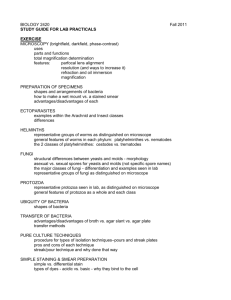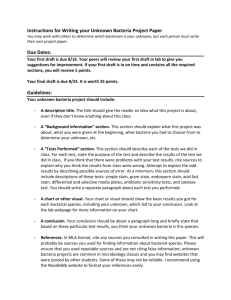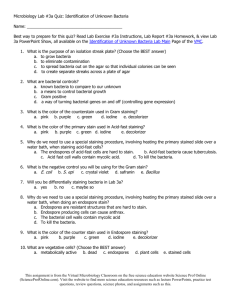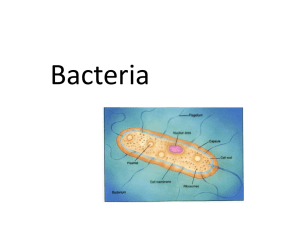Exercise 14: Bacterial Endospores
advertisement
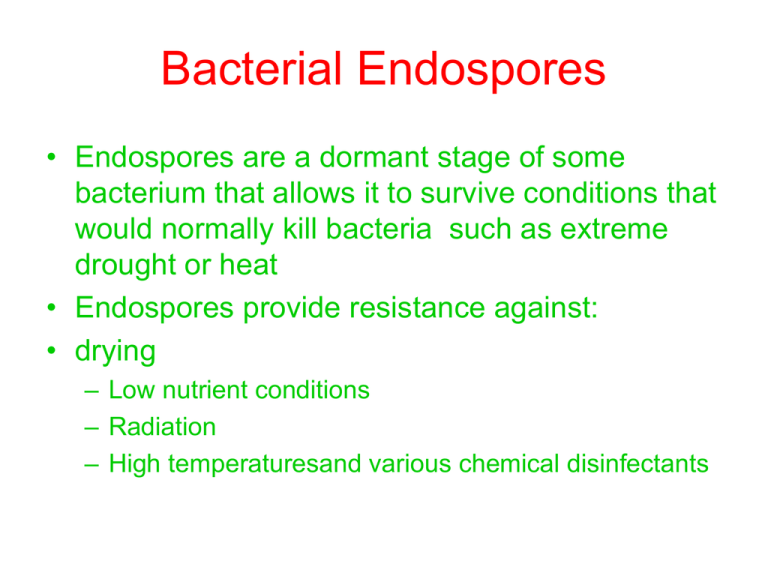
Bacterial Endospores • Endospores are a dormant stage of some bacterium that allows it to survive conditions that would normally kill bacteria such as extreme drought or heat • Endospores provide resistance against: • drying – Low nutrient conditions – Radiation – High temperaturesand various chemical disinfectants Endospores form within the Cell The Vegetative Cell Gives Rise to One Spore Bacterial CellCell Bacterial Spore Bacterial Cell The endospore is able to survive for long periods of time until environmental conditions again become favorable for growth. The endospore then germinates, producing a single vegetative bacterium. Endospore Function • Endospores are ultimately protection for the bacterial genome • Spores form within the cell and contain a full copy of the bacterium’s genome • Endospores are not a form of reproduction, because only one new cell germinates from each spore • Spores can be variable in size and location within the cell Not all bacterial species can form spores • A few genera of bacteria produce Endospore such as Clostridium (gangrene) and Bacillus (anthrax), both of them are gram + rods • (Endospore production is associated with Gram Positive bacteria) • Since not all bacteria form endospores, we can use this as an identification factor The shape of the spore is an identifying characteristic • Swelled vs. Not swelled spore Bacterial cell spore Bacterial cell The location of the spore is also an identifying characteristic • Central, Sub-Terminal, and Terminal spores Some spore forming bacteria are capable of causing disease • • • • Clostridium botulinum – botulism Clostridium perfingens – gas gangrene Clostridium tetani – tetanus Bacillus anthracis – Woolsorter’s Disease and wound infections • The Schaeffer-Fulton Stain Procedure is used to differentiate between endospores and vegetative cells Schaeffer-Fulton Stain Procedure 1. Make a smear. Air Dry. Heat fix 2. Flood the smear with Malachite Green stain 3. Cover the flooded smear with a square of filter paper 4. Steam slide for 10 minutes (every minute, add a few more drops of Malachite Green stain) 5. Allow slide to cool (after the 10 min. steam process) Schaeffer-Fulton Stain Procedure (continued) 6. Drain slide and rinse for 30 seconds with DI water (discard filter paper) 7. Put slide on steam rack 8. Flood smear with Safranin (counter stain). This stains the vegetative cell. (Leave for 1 minute) 9. Drain the slide and rinse with DI water 10. Blot Dry 11. Use oil immersion objective to view Endospore Stain Example Spores: Green Cell: Red or Pink Each Person will make a smear and Endospore stain of: Bacillus pumilus or Bacillus subtilis BACTERIAL MOTILITY Examination for Motility by Hanging Drop Technique –Many bacteria show no motion and are termed nonmotile. However, in environment these bacteria appear to be moving erratically. This erratic movement is Brownian movement. Brownian movement results from the random motion of the water molecules bombarding the bacteria and causing them to move. • True motility has been recognized in other bacteria and involves several different mechanisms. Most motile bacteria propel themselves by special organelles termed flagella. • The above types of motility or nonmotility can be observed in a hanging drop slide. Hanging drop slides are also useful in observing the general shape of living bacteria and the arrangement of bacterial cells. • A ring of Vaseline around the edge of the cover-slip keeps the slide from drying out PROCEDURE • 1. With a toothpick, spread a small ring of Vaseline around the concavity of a depression slide. • 2. use the inoculating loop to aseptically place a small drop of one of the bacterial suspensions in the center of a coverslip . • 3. Lower the depression slidedown onto the coverslip • 4. Turn the hanging drop slide over and place on the stage of the microscope so that the drop is over the light hole. • 5. Examine the drop by first locating its edge under low power and focusing on the drop. Switch to the high-dry objective and then, using immersion oil, to the 100x objective. In order to see the bacteria clearly, close the diaphragm as much as possible for increased contrast. Note bacterial shape, size, arrangement, and motility. Be careful to distinguish between motility and Brownian movement The arrangement of the flagella about the bacterium is of use in classification and identification • 1. monotrichous - a single flagellum at one pole • 2. amphitrichous - single flagella at both poles • 3. lophotrichous - two or more flagella at one or both poles of the cell • 4. peritrichous - completely surrounded by flagella
